We may not have the course you’re looking for. If you enquire or give us a call on +420 210012971 and speak to our training experts, we may still be able to help with your training requirements.
Training Outcomes Within Your Budget!
We ensure quality, budget-alignment, and timely delivery by our expert instructors.
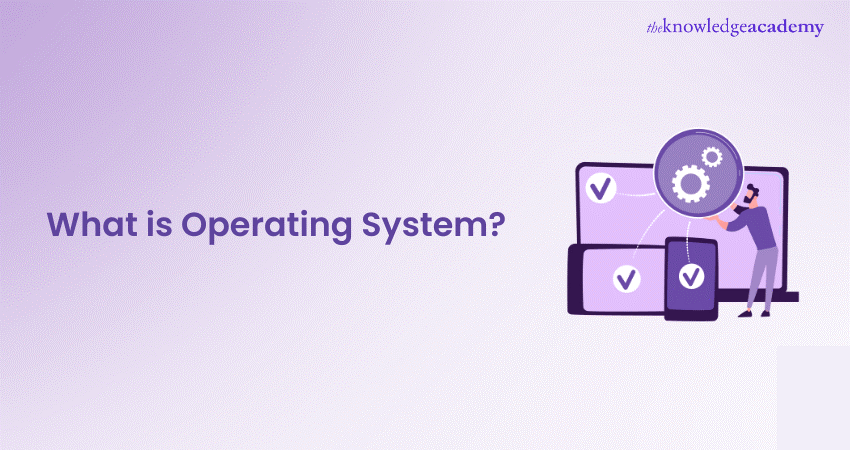
Have you ever wondered what makes your computer work? How do you interact with your computer and run different programs and applications? How does your computer communicate with other devices and networks? The answer to all these questions lies in the Operating System (OS) of your computer. But what is an Operating System? An Operating System is a software program that manages the hardware and software resources of a computer and provides a convenient environment for users and applications.
According to Statcounter, Android, an Operating System using Linux Kernel, is the world's most used Operating System. There are many popular OS in the market. In this blog, we will explore What is Operating System, along with their components, features, functions, types, and some of the popular Operating Systems in the market. By the end of this blog, you will have a better understanding of what an Operating System is and how it works.
Table of Contents
1) What is an Operating System?
2) Components of an Operating System
3) Features of an Operating System
4) Functions of an Operating System
5) Types of Operating Systems
6) Popular Operating Systems
7) Conclusion
What is an Operating System?
An Operating System (OS) is a software program that manages the hardware and software resources of a computer. The OS performs basic tasks, such as controlling and allocating memory, prioritising system requests, controlling input and output devices, facilitating network communication, and managing files.
The OS acts as an interface between the user and the computer hardware, allowing the user to execute programs and access data. The OS also provides services to other software programs, such as device drivers, libraries, and system utilities.
Components of an Operating System
An Operating System consists of several components that work together to provide the functionality and performance of the system. Some of the main components are:
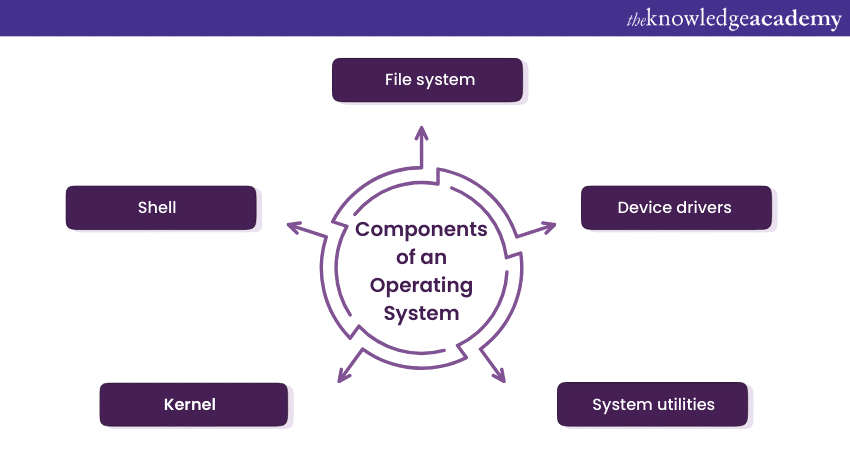
Kernel
The Kernel is the core component of the OS that runs in the privileged mode of the processor. It is responsible for managing memory, processes, devices, interrupts, and system calls. The kernel provides low-level services to the user programs and interacts directly with the hardware.
Shell
The shell is the component of the OS that provides a User Interface (UI) to interact with the system. The shell can be either graphical or command-line-based. The shell interprets the user commands and executes them by invoking the appropriate system programs or utilities.
File system
The file system is the component of the OS that organises and stores data on the disk. The file system manages the allocation, access, and protection of files and directories. The file system also maintains metadata, such as file name, size, type, permissions, and location.
Device drivers
Device drivers are software modules that communicate with specific hardware devices, such as keyboards, mice, printers, scanners, etc. Device drivers translate the high-level commands from the OS or user programs into low-level instructions for the hardware devices. Device drivers also handle errors and interrupts from the devices.
System utilities
System utilities are software programs that perform various tasks related to the maintenance and operation of the system. Some examples of system utilities are file managers, backup tools, antivirus programs, disk defragmenters, etc. System utilities can be either part of the OS or installed separately by the user.
Features of an Operating System
An Operating System can have different features depending on its design goals and target audience. Some of the common features are:
Multitasking
Multitasking is the ability of an OS to run multiple programs concurrently on a single processor or multiple processors. Multitasking allows users to perform multiple tasks at the same time without waiting for one program to finish before starting another.
Multiprocessing
Multiprocessing is the ability of an OS to utilise multiple processors or cores in a single system. Multiprocessing enables parallel processing of tasks and improves the performance and efficiency of the system.
Multithreading
Multithreading is the ability of an OS to execute multiple threads within a single process. A thread is a sequence of instructions that can be executed independently by a processor or core.
Memory management
Memory management is the process of allocating and deallocating memory to processes and programs. Memory management ensures that each process has enough memory to run, and that no memory is wasted or corrupted. Memory management also involves swapping or paging techniques to move data between main memory and secondary storage when needed.
Security
Security is the feature of an OS that protects the system from unauthorised access, modification, or damage. Security involves authentication, authorisation, encryption, auditing, and firewall mechanisms to prevent attacks from external or internal sources.
User Interface
User Interface is the feature of an OS that allows users to interact with the system using graphical or textual elements. The User Interface (UI) includes windows, menus, icons, buttons, cursors, etc., for graphical mode and commands, prompts, messages, etc., for command-line mode.
Unlock your mobile app development potential today with our comprehensive Windows 11 Overview For The IT Professional Training. Join now!
Functions of an Operating System
An Operating System performs various functions to ensure the smooth operation of the system and provide a convenient environment for users and applications. Some of the main functions are:
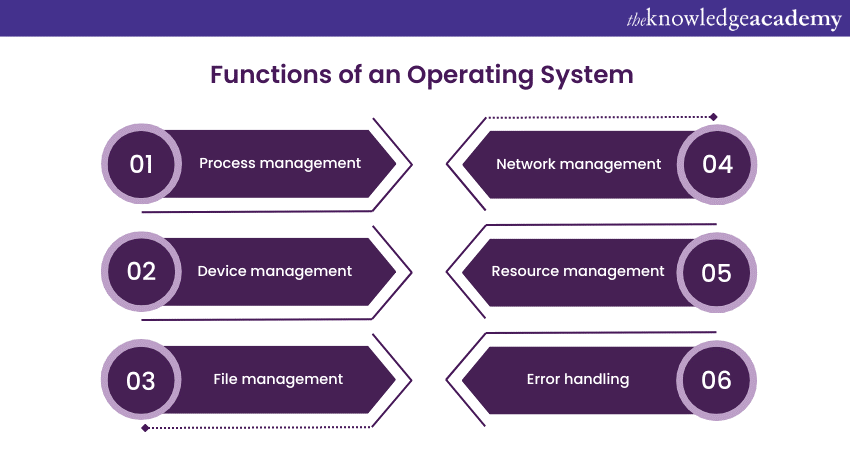
Process management
Process Management is the function of an OS that creates, schedules, monitors, and terminates processes. A process is an instance of a program in execution. Process management involves assigning priorities, resources, states, and identifiers to processes, creating inter-process communication channels, handling process synchronisation and deadlock issues, etc.
Device management
Device management is the function of an OS that controls and coordinates the use of hardware devices by processes and programs. Device management involves detecting, installing, configuring, updating, and removing device drivers; allocating and releasing devices; buffering and caching data; handling device errors and interrupts; etc.
File management
File management is the function of an OS that creates, modifies, deletes, and accesses files and directories. File management involves maintaining file attributes, permissions, and ownership; creating and managing file systems; providing file locking and sharing mechanisms; supporting different file formats and types; etc.
Network management
Network management is the function of an OS that enables communication and data exchange between different systems over a network. Network management involves implementing network protocols, standards, and architectures; providing network services, such as DNS, DHCP, FTP, HTTP, etc.; managing network devices, such as routers, switches, hubs, etc.; ensuring network security, reliability, and performance; etc.
Resource management
Resource management is the function of an OS that allocates and optimises the use of system resources, like CPU, disk, memory, etc., by processes and programs. Resource management involves implementing resource allocation policies and algorithms, monitoring and measuring resource utilisation and performance, resolving resource contention and conflicts, etc.
Error handling
Error handling is the function of an OS that detects and resolves errors that occur in the system. Errors can be hardware or software-related, such as device failures, power outages, memory faults, program bugs, etc. Error handling involves identifying the source and cause of errors, reporting and logging errors, recovering from errors, terminating faulty processes or programs, etc.
Unlock your potential in app and web development with our App & Web Development Training – Join now!
Types of Operating Systems
Types of Operating Systems can be classified based on various criteria, such as the number of users, the number of tasks, the type of hardware, the type of interface, etc. Some of the common types are:
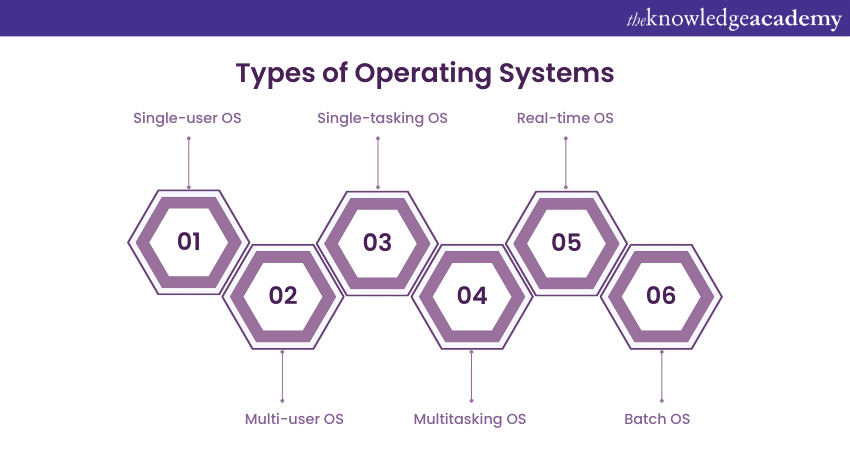
Single-user OS
A single-user OS is an OS that allows only one user to access the system at a time. A single-user OS is designed for personal or individual use, such as desktops or laptops. Examples of single-user OS are Windows, macOS, Linux Mint, etc.
Multi-user OS
A multi-user OS is an OS that allows multiple users to access the system simultaneously. A multi-user OS is designed for shared or collaborative use, such as servers or mainframes. Examples of multi-user OS are Unix, Linux, Windows Server, etc.
Single-tasking OS
A single-tasking OS is an OS that allows only one program to run at a time. A single-tasking OS is simple and efficient but limits the functionality and performance of the system. Examples of single-tasking OS are MS-DOS, Palm OS, etc.
Multitasking OS
A multitasking OS is an OS that allows multiple programs to run concurrently. A multitasking OS is complex and powerful but requires more resources and Management. Examples of multitasking OS are Windows, macOS, Linux Mint, etc.
Real-time OS
A real-time OS is an OS that responds to events or inputs within a specified time limit. A real-time OS is designed for time-critical or mission-critical applications, such as embedded systems or industrial control systems. Examples of real-time OS are QNX, VxWorks, RTLinux, etc.
Batch OS
A batch OS is an OS that processes a set of commands or jobs in a sequential order without user intervention. A batch OS is designed for batch processing or offline processing applications, such as data analysis or report generation. Examples of batch OS are IBM z/OS, MS-DOS (in batch mode), etc.
Distributed OS
A distributed OS is an OS that manages a collection of independent computers or nodes as a single system. A distributed OS is designed for distributed computing or parallel computing applications, such as Cloud Computing or grid computing. Examples of distributed OS are Plan 9 from Bell Labs, Amoeba, etc.
Unlock your mobile app development potential today with our comprehensive Mobile App Development Training. Join now!
Popular Operating Systems
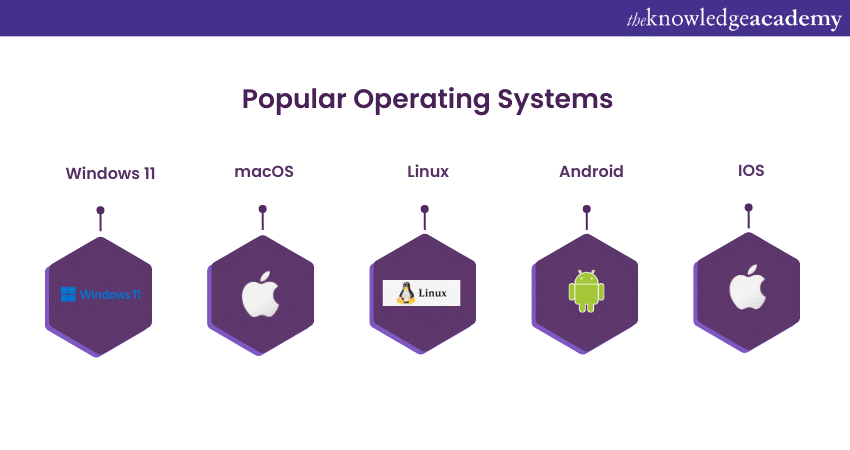
Some of the most popular Operating Systems in the market are:
Windows 11
Windows 11 is a multi-user and multitasking Operating System developed by Microsoft Corporation. Windows 11 is the latest version of the Windows family of Operating Systems that runs on personal computers (PCs), laptops, tablets, smartphones, etc. Windows 11 offers a Graphical User Interface (GUI) with features such as Cortana (a virtual assistant), Edge (a web browser), Xbox (a gaming platform), Office (a productivity suite), etc.
Some of the advantages of Windows are:
a) It has a large and diverse user base and market share, attracting many software and hardware developers and vendors
b) It has access to a huge number of applications and games from various sources, such as the Microsoft Store, Steam, and other websites
c) It has support for various file systems, such as NTFS, FAT, exFAT, and ReFS, and can read and write to most storage devices
d) It has compatibility with many devices and peripherals, such as printers, scanners, cameras, keyboards, mice, etc.
Some of the disadvantages of Windows are:
a) It is vulnerable to virus attacks and malware infections, requiring frequent updates and antivirus software to protect the system
b) It has performance issues and stability problems on some devices, especially older or low-end ones
c) It has privacy concerns and data collection practices that may compromise the user's personal information and preferences
macOS
macOS is a multi-user and multitasking Operating System developed by Apple Inc. macOS is the current version of the Macintosh OS that runs on Mac computers, laptops, tablets, smartphones, etc. macOS offers a GUI with features such as Siri (a virtual assistant), Safari (a web browser), iTunes (a media player), iWork (a productivity suite), etc
Some of the advantages of macOS are:
a) It has fewer virus attacks and better security than Windows
b) It has a streamlined and user-friendly interface that is easy to navigate and operate
c) It has better and more consistent integration between the Operating System and the hardware, resulting in efficient and stable performance
d) It has some useful pre-installed apps, such as iPhoto and iMovie, and supports NTFS and FAT file systems
e) It can run Windows using Bootcamp or Parallel software
Some of the disadvantages of macOS are:
a) It is expensive to purchase and also to maintain when compared with other popular OS like Windows or Linux computers
b) It has fewer games and software available, especially for professional or creative purposes
c) It has compatibility issues with some older or newer hardware or software
Linux
Linux is a multi-user and multitasking Operating System developed by Linus Torvalds and other contributors. Linux is an open-source and free Operating System that runs on various platforms, such as PCs, laptops, servers, smartphones, etc. Linux offers a command-line interface (CLI) or a GUI with features such as GNOME (a desktop environment).
Some of the advantages of Linux are:
a) It is secure and reliable, having fewer virus attacks and malware infections than Windows or macOS
b) It is fast and efficient, having lower system requirements and resource consumption than Windows or macOS
c) It is flexible and customisable, allowing the user to choose from various distributions, desktop environments, themes, settings, etc.
d) It is powerful and versatile, having many tools and features for various purposes, such as programming, networking, gaming, etc.
Some of the disadvantages of Linux are:
a) It requires technical knowledge and skills to maintain and operate the system
b) It has limited support and compatibility with some software and hardware, especially proprietary ones that are designed for Windows or macOS
c) It has fragmentation issues due to different versions and variants of Linux distributions, making it difficult to standardise and optimise the system
Android
Android is a multi-user and multitasking OS developed by Google and the Open Handset Alliance. Android is a mobile OS that runs on devices like smartphones, tablets, smart TVs, smart watches, etc. Android offers a GUI with features such as Google Assistant (a virtual assistant), Chrome (a web browser), Play Store (an app store), etc. Some of the advantages of Android are:
a) It has a large market share and popularity in the mobile industry, attracting many app developers and users
b) It has access to a huge number of apps and games from the Google Play Store, as well as other sources such as APK files or third-party app stores
c) It has regular updates and patches to fix bugs and improve security and performance
d) It has a high degree of customisation and personalisation, allowing the user to change various aspects of the system, such as themes, icons, fonts, etc.
Some of the disadvantages of Android are:
a) It is prone to fragmentation due to different versions and models of devices, making it difficult to optimise apps and features for all users
b) It is prone to malware and hacking attacks, especially through rooting or sideloading apps
c) It has poor battery life and performance issues on some devices, especially older or low-end ones
IOS
iOS is a multi-user and multitasking Operating System developed by Apple Inc. iOS is a mobile Operating System that runs on iPhones, iPads, iPods, Apple TVs, etc. iOS offers a GUI with features such as Siri (a virtual assistant), Safari (a web browser), App Store (an app store), etc.
Some of the advantages of iOS are:
a) It has a large market share and popularity in the mobile industry, attracting many app developers and users
b) It has access to a huge number of apps and games from the App Store and supports various features such as voice control, gesture control, and facial recognition
c) It has regular updates and patches to fix bugs and improve security and performance.
d) It has a simple and intuitive interface that is easy to use and operate
Some of the disadvantages of iOS are:
a) It is prone to fragmentation due to different versions and models of devices, making it difficult to optimise apps and features for all users
b) It is prone to malware and hacking attacks, especially through jailbreaking or sideloading apps
c) It has poor battery life and performance issues on some devices, especially older ones
Conclusion
In this blog, we have learned all about an Operating System and its main functions. We have also seen some examples of popular Operating Systems such as Windows, Linux, and MacOS. Operating Systems are essential for the smooth and efficient operation of computers and devices. They enable us to perform various tasks such as browsing the web, playing games, editing documents, and more. Without Operating Systems, we would not be able to use computers as we do today. Therefore, understanding What Is Operating System and how it works can help us appreciate the power and potential of computing technology.
Unlock your potential in iOS App Development with our IOS App Development Training – Start building amazing apps today.
Frequently Asked Questions
Upcoming Programming & DevOps Resources Batches & Dates
Date
 Introduction to HTML
Introduction to HTML
Fri 24th Jan 2025
Fri 28th Mar 2025
Fri 23rd May 2025
Fri 25th Jul 2025
Fri 26th Sep 2025
Fri 28th Nov 2025







 Top Rated Course
Top Rated Course



 If you wish to make any changes to your course, please
If you wish to make any changes to your course, please


